
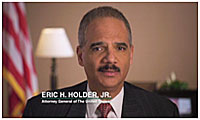
"Our children are exposed to violence every day in their neighborhoods, in their schools, even in their own homes," said Attorney General Holder in his PSA remarks. "Exposure to violence can have a devastating and lifelong impact. Through community action and leadership at the national level, we're identifying the children who need our help."
 A key component of the Defending Childhood initiative is a two-phase, multiyear demonstration program. Eight sites have received funding to conduct comprehensive needs assessments and to develop strategic plans to prevent and reduce the impact of children's exposure to violence in their homes, schools, and communities. In addition to the demonstration program grants, DOJ has committed additional funding for research, evaluation, public awareness, and technical assistance related to the initiative.
A key component of the Defending Childhood initiative is a two-phase, multiyear demonstration program. Eight sites have received funding to conduct comprehensive needs assessments and to develop strategic plans to prevent and reduce the impact of children's exposure to violence in their homes, schools, and communities. In addition to the demonstration program grants, DOJ has committed additional funding for research, evaluation, public awareness, and technical assistance related to the initiative.
On May 6, 2011, the Attorney General traveled to Boston to join Massachusetts Attorney General Martha Coakley at a luncheon event sponsored by the Robert F. Kennedy Children's Action Corps, a private nonprofit organization that offers community-based services, residential treatment, educational support, and other programs for youth living in areas of high violence and crime.
"So long as I am Attorney General, I pledge that protecting our children from violence will remain a top priority for me, for the Justice Department, and for this Administration at the Cabinet level," Mr. Holder said. "I'm proud that today's Justice Department has made an historic commitment to this work. Through our Defending Childhood initiative, we are directing resources for the express purpose of reducing childhood exposure to violence."
The Attorney General highlighted the National Forum on Youth Violence Prevention as another promising tool in this effort. Launched in October 2010 at the direction of the President by DOJ and the U.S. Department of Education along with other federal agencies and participating localities, the forum supports teams of community stakeholders and leaders in selected cities across the country in implementing comprehensive, researched-based violence prevention and reduction plans. The forum's support to cities includes information, technical assistance, training, and coordination.
In a Webcast later that day at the Harvard School of Public Health, the Attorney General discussed, among other priorities, the importance of developing evidence-based strategies to prevent and reduce the impact of children's exposure to violence.
"Restoring scientific decisionmaking at the Justice Department is one of my highest priorities," Mr. Holder said. "And while research has told us much about the incidence and impact of violence, it hasn't yet told us everything. We need more information about what works—and what doesn't—so that policymakers and practitioners can make informed decisions about how to tackle the problem and tailor approaches to meet the needs of individual communities."
What We Know About Children's Exposure to Violence
Researchers at the University of New Hampshire's Crimes Against Children Research Center determined that in the year preceding the National Survey of Children's Exposure to Violence—
- Almost 40 percent of those surveyed were direct victims of 2 or more violent acts, and 1 in 10 were victims of violence 5 or more times.
- Almost 15 percent of children experienced an assault with a weapon and were injured as a result.
- One in ten suffered some form of child maltreatment.
- One in four were victims of robbery, vandalism, or theft.
- One in sixteen were victimized sexually.
- One in four witnessed a violent act.
- Almost 1 in 10 saw one family member assault another family member.
Resources:
The Attorney General's PSA and detailed information about the Defending Childhood initiative may be accessed via the Defending Childhood Harvard School of Public Health's Webcast.
For a summary of the findings from the National Survey of Children's Exposure to Violence, read the OJJDP bulletin, Children's Exposure to Violence: A Comprehensive National Survey.
OJJDP's Safe Start Center serves as a national resource for information and training to communities that are implementing strategies for reducing the impact of children's exposure to violence. For more information, visit the center's Web site.

Children's Day poster
Speakers at the ceremony included James Cole, Deputy Attorney General; Ernie Allen, President and CEO of the National Center for Missing & Exploited Children (NCMEC); and Mika Moulton, the parent of an abducted child and founder of Christopher's Clubhouse, a community safety education program. OJJDP Acting Administrator, Jeff Slowikowski, made the opening and closing remarks.
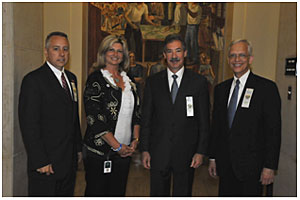
Speakers at DOJ's National Missing Children's Day ceremony included (from l. to r.) Jeff Slowikowski, OJJDP Acting Administrator; Mika Moulton, founder of Christopher's Clubhouse, a community safety education program; James Cole, Deputy Attorney General; and Ernie Allen, President and CEO of the National Center for Missing & Exploited Children.
According to NCMEC, an estimated 800,000 children are reported missing in the United States every year—more than 2,000 children each day. Twenty-eight years ago, President Ronald W. Reagan proclaimed May 25 as National Missing Children's Day in memory of Etan Patz, a 6-year-old boy who disappeared from a New York City street corner on that day in 1979. He is still missing.
National Missing Children's Day honors the memory of children who are still missing, celebrates the stories of recovery, and pays tribute to the exemplary efforts of agencies, organizations, and individuals engaged in protecting children.
"National Missing Children's Day is a reminder to all parents and guardians of the need for high-quality photographs of their children for use in case of an emergency, [and for] vigilant efforts by the public to pay close attention to the posters, AMBER Alerts, and posted photographs of missing children," said Deputy Attorney General Cole.
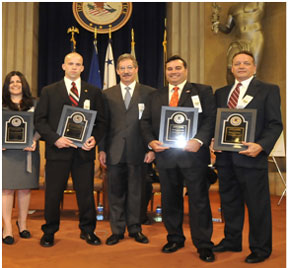
Deputy Attorney General James Cole (center) presented the Attorney General's Special Commendation Award to (from l. to r.) Assistant U.S. Attorney Maria Medetis, Southern District of Florida; Special Agent Tim Aucoin, U.S. Secret Service, Miami; Detective Felix Mendigutia, Hialeah Police Department (Florida); and Detective Gary Jackson, Miami Police Department.
- The Attorney General's Special Commendation Award: Detective Gary Jackson, Miami Police Department; Detective Felix Mendigutia, Hialeah Police Department (Florida); Special Agent Tim Aucoin, U.S. Secret Service, Miami; and Assistant U.S. Attorney Maria Medetis, Southern District of Florida. These individuals were involved in the identification and location of a sexual predator and four child victims he was sexually abusing. The defendant received a 130-year prison sentence.
- Missing Children's Law Enforcement Award: Sheriff David Barber, Knox County, OH, Sheriff's Office. Barber coordinated a high-profile investigation including federal, state, and local law enforcement that led to the safe recovery of an abducted 13-year-old girl.
- Missing Children's Citizen Award: Heather Picklesimer, U.S. Postal Service, Ducktown, TN. Her work with the U.S. Postal Inspection Service led to the successful recovery of a missing infant.
- Missing Children's Child Protection Award: Detective Dana Ward, York City Police Department (Pennsylvania). Detective Ward was a primary investigator in a 2010 case in which two York parents were arrested and charged with five counts of child endangerment after they hid their five children in a squalid row house with no heat, electricity, or running water.
Julianna Hinton of Oak Grove Elementary School, Hattiesburg, MS, won the Missing Children's Art Contest Award. Her artwork will be used as the basis of the poster for next year's National Missing Children's Day.
Acting OJJDP Administrator Slowikowski officially released three new publications—
- The Spanish-language translations of The Crime of Family Abduction: A Child's and Parent's Perspective, which offers insights into how an abduction of a child by a family member affects the child and the family; and When Your Child Is Missing: A Family Survival Guide, 4th ed., one of the resources most widely requested and used by families of missing and abducted children.
- The latest edition of Federal Resources on Missing and Exploited Children: A Directory for Law Enforcement and Other Public and Private Agencies, a guide to the services, programs, publications, and training offered by the 16 federal and 2 nonfederal agencies that make up the Federal Agency Task Force for Missing and Exploited Children.
For more information about these publications, see the New Publications section in this issue.
The ceremony began and concluded with performances by the Benjamin Orr Elementary School Choir of Washington, DC. The Office of Justice Programs has had a relationship with the Orr School since 1991 as part of DOJ's volunteer outreach program.
Transcript of Hillary Rodham Clinton's Video Remarks
Last year, parents abducted nearly 2,000 children to or from the United States. That's 40 children taken from their homes and from their loved ones each week. Abductions traumatize children, their parents, friends, and family. International Parental Child Abduction is a painful scourge for so many, and it is something that deeply concerns me.
At the State Department, we are committed to preventing child abduction and to helping the children and families caught up in these very complex situations. Our dedicated staff in the Office of Children's Issues works everyday to support families and children at risk. We help parents access the tools available to prevent international abductions, such as our Passport Issuance Alert Program.
When an abduction does occur however, we work with parents to identify the appropriate response and find the resources that can help bring their children home. In 2010, for example, we helped more than 575 children return to their homes and families, both in the United States and in countries around the world.
This work extends beyond individual families. So, we are encouraging foreign governments to join us as parties to The Hague Convention on Child Abduction. Today we are treaty partners with 68 countries, and we want that number to grow. This convention is a necessary tool for resolving these difficult cases and giving more children the opportunity to come home. On this National Missing Children's Day, let's continue to stand up, speak out, and do our part to keep our most vulnerable citizens safe. And let's help children around the world come home.
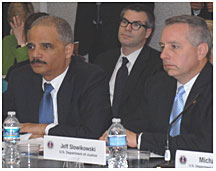
Shown at the May 23, 2011, meeting of the Coordinating Council on Juvenile Justice and Delinquency Prevention are (from l. to r.) Attorney General Eric Holder; Thomas Abt, Chief of Staff, Office of Justice Programs; and Jeff Slowikowski, Acting Administrator, OJJDP.
Michael Thompson, Director of the Council of State Governments (CSG) Justice Center, summarized the results of a forthcoming study tracking the disciplinary history through 12th grade of nearly 1 million youth in Texas who entered seventh grade between 2000 and 2003. The study matched records of school disciplinary action with juvenile justice system records to assess later interaction with the juvenile justice system. CSG will officially release the results of the study in July.
Christopher Boccanfuso of Web site.
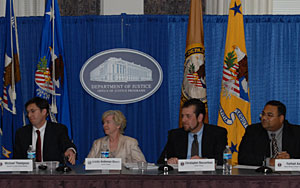
Participating in a panel discussion on trends in school disciplinary practices and preventing school dropout were (from l. to r.) Michael Thompson, Director of the Council of State Governments Justice Center; Drs. Kristin Moore and Christopher Boccanfuso of Child Trends; and Farhad Asghar, Associate Dean of Continuing Education at Bank Street College of Education.
Other Highlights of the Council Meeting
OJJDP's Acting Administrator Jeff Slowikowski, who serves as vice-chair of the Coordinating Council, provided an update on the progress of the council's issue teams toward finalizing recommendations on enhancing federal policy and practice in four priority areas: education and at-risk youth, tribal youth and juvenile justice, juvenile reentry and transition to adulthood, and racial and/or ethnic disparities in the juvenile justice and related systems. Those recommendations will be officially presented in a consolidated report to the Coordinating Council at its next meeting on July 21, 2011. Recommendations that are approved by the council will be incorporated into a separate report submitted by the council to Congress. Each team has produced draft recommendations specific to their topic area, as well as a number of cross-cutting proposals that are more broadly relevant.
Thomas Abt, Chief of Staff for the Office of Justice Programs, provided an overview of the National Forum on Youth Violence Prevention, a network of agencies and localities who share information, offer technical assistance, and coordinate action and resources to address youth violence. Federal agencies involved in the project include the U.S. Departments of Justice, Education, Health and Human Services, and Housing and Urban Development; and the Office on National Drug Control Policy. Current member cities are Boston, Chicago, Detroit, Memphis, San Jose, and Salinas, CA. Teams of experts presented comprehensive plans to prevent youth violence in their cities at the Summit on Preventing Youth Violence on April 4–5, 2011, in Washington, DC.
 OJJDP released Highlights of the 2009 National Youth Gang Survey at the National Gang Symposium on June 7–10, 2011. Since 1996, the National Gang Center, through the National Youth Gang Survey (NYGS), has collected data annually for the survey from a large, representative sample of local law enforcement agencies to track the size and scope of the national gang problem.
OJJDP released Highlights of the 2009 National Youth Gang Survey at the National Gang Symposium on June 7–10, 2011. Since 1996, the National Gang Center, through the National Youth Gang Survey (NYGS), has collected data annually for the survey from a large, representative sample of local law enforcement agencies to track the size and scope of the national gang problem.
Based on law enforcement reports, in 2009—
- There were an estimated 28,100 gangs and 731,000 gang members throughout 3,500 jurisdictions nationwide.
- The prevalence rate of gang activity increased to 34.5 percent from 32.4 percent in 2008.
- Sixty-six percent of the 167 responding cities with populations of more than 100,000 reported a total of 1,017 gang homicides.
The fact sheet contains a trend analysis that reveals several distinctive patterns in the prevalence of gang activity over the 14-year survey period:
- A peak in reported gang activity in 1996.
- A sharp decline nationwide throughout the late 1990s.
- A sudden upturn beginning in 2001 that continued until 2005, almost reaching the high level observed in 1996.
- A leveling off thereafter.
Over the 8-year period from 2002 to 2009, the number of jurisdictions with gang problems and the number of gangs increased more than 20 percent, while the number of gang members averaged approximately 750,000. Closer examination of the data covering this period has revealed some important findings with respect to the seriousness of gang activity:
- Gang-related homicides remain highly concentrated in the most populated jurisdictions, with larger cities and suburban counties accounting for more than 96 percent of all gang-related homicides recorded in the NYGS in 2009.
- Gang-related homicides are up in larger cities with populations greater than 100,000—a 7-percent increase from 2005 to 2009, and an 11-percent jump from 2008 to 2009.
In sum, gangs and their activities remain a serious concern for law enforcement agencies and the public in many jurisdictions across the United States. This new national data reveals that gang violence rates have continued at exceptional levels over the past decade.
Resources:
To read Highlights of the 2009 National Youth Gang Survey, visit the OJJDP Web site. A more detailed trend analysis of gang activity over the past decade is available on the National Gang Center's Web site.
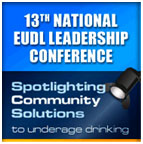 OJJDP's 13th annual National EUDL Leadership Conference, "Spotlighting Community Solutions to Underage Drinking," will take place in Orlando, FL, on August 10–12, 2011.
OJJDP's 13th annual National EUDL Leadership Conference, "Spotlighting Community Solutions to Underage Drinking," will take place in Orlando, FL, on August 10–12, 2011.
Held in conjunction with the National Liquor Law Enforcement Association, the conference will include plenary sessions along with workshop presentations by law enforcement personnel, judicial professionals, youth, researchers, and community leaders. Preconference activities for EUDL Coordinators and invited guests, experiential learning exercises, and a youth track also will be available.
EUDL Coordinators, law enforcement officers, executives, military personnel, judges, prosecutors, probation officials, youth, government officials, staff members of community-based organizations, and other professionals involved in addressing the issue of underage drinking are encouraged to attend.
Workshop presentations will cover the following topics:
- Strategies to reduce the availability of alcohol to youth in retail and social environments and to support the enforcement of underage drinking laws.
- The engagement of youth leaders and groups in community efforts to reduce the availability of alcohol.
- Innovative enforcement operations and techniques.
- Judicial, prosecutorial, and probation initiatives for the management of underage drinking cases or dockets.
- Current research in the area of underage drinking causes and prevention.
For more information and to register, visit the National EUDL Leadership Conference Web site.
 Register Now: OJJDP's National Conference: October 12–14, 2011
Register Now: OJJDP's National Conference: October 12–14, 2011
OJJDP will hold its National Conference at the Gaylord Hotel & Convention Center in National Harbor, MD. The conference will bring together juvenile justice practitioners and policymakers from across the country to share current trends and promising practices in the juvenile justice field. Registration is free and available online.
17th Annual Drug Court Training Conference: July 17–20, 2011
Hosted by the National Association of Drug Court Professionals, this Web site.
National Council of Juvenile and Family Court Judges Conference: July 24–27, 2011
 The National Council of Juvenile and Family Court Judges will hold its 74th annual online.
The National Council of Juvenile and Family Court Judges will hold its 74th annual online.
Office of Safe and Drug-Free Schools National Conference: August 8–10, 2011
The U.S. Department of Education's Office of Safe and Drug-Free Schools (OSDFS) will host its national conference, "online until July 22, 2011, or until space is no longer available.
Crimes Against Children Conference: August 8–11, 2011
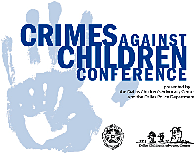 Sponsored by the Dallas Children's Advocacy Center and the Dallas Police Department, this Web site.
Sponsored by the Dallas Children's Advocacy Center and the Dallas Police Department, this Web site.
National Conference on Child Sexual Abuse and Exploitation Prevention: August 23–25, 2011
The 12th online.
National Conference on Substance Abuse, Child Welfare and the Courts: September 14–16, 2011
 Sponsored by Children and Family Futures, "Web site.
Sponsored by Children and Family Futures, "Web site.
National Symposium for Juvenile Services To Highlight System Reform: October 16–19, 2011
The National Partnership for Juvenile Services will host a national symposium in Indianapolis, IN, on "Web site.
International Association of Chiefs of Police Annual Conference: October 22–26, 2011
 To be held in Chicago, IL, this annual Web site.
To be held in Chicago, IL, this annual Web site.
Multi-System Integration Certificate Program: November 2–8, 2011
The Center for Juvenile Justice Reform at Georgetown University's Public Policy Institute will hold its Web site.
Justice Department Awards Presented at National Strategy Conference

National Strategy Conference on Combating Child Exploitation logo
"Through their work in urban, rural, and tribal communities—and through cutting-edge online efforts—these individuals are advancing bold, innovative, and collaborative solutions to keep our children safe from all forms of exploitation and abuse," said Attorney General Holder. "By focusing on prevention and intervention, as well as proven enforcement and prosecution strategies, these award recipients are strengthening our ability to protect children in need and at risk, and to bring offenders to justice."
The national strategy conference is organized jointly by the U.S. Department of Justice's (DOJ's) Project Safe Childhood and the Internet Crimes Against Children (ICAC) task force program. This year's conference included more than 150 lecture sessions and more than 70 interactive computer lab workshops. Training was provided to Project Safe Childhood coalitions; ICAC task forces; and other federal, state, and local law enforcement agencies in the areas of investigation, forensics, prosecution, community outreach, and capacity building.
SAMHSA Releases School Toolkit for Suicide Prevention
The Substance Abuse and Mental Health Services Administration's Suicide Prevention Resource Center has released "online.
Course Offered on Law Enforcement Interactions With Adolescent Girls
 On May 5–6, 2011, in Dallas, TX, law enforcement officers from 34 jurisdictions and 5 states participated in Law Enforcement Responses to Adolescent Girls, a course developed by OJJDP in partnership with the International Association of Chiefs of Police (IACP). Through presentations, group discussions, and exercises, the training assists law enforcement officers in learning strategies to promote more positive interactions with adolescent girls who may be at risk of, or involved in, delinquency. The course examines common issues that arise in policing situations involving girls, current trends in girls' behavior, and pathways to delinquency in girls. The course also focuses on the interpretation of adolescent girls' behavior, communication strategies, the de-escalation of potential crisis situations, proactive engagement with at-risk girls, and the effective use of community resources.
On May 5–6, 2011, in Dallas, TX, law enforcement officers from 34 jurisdictions and 5 states participated in Law Enforcement Responses to Adolescent Girls, a course developed by OJJDP in partnership with the International Association of Chiefs of Police (IACP). Through presentations, group discussions, and exercises, the training assists law enforcement officers in learning strategies to promote more positive interactions with adolescent girls who may be at risk of, or involved in, delinquency. The course examines common issues that arise in policing situations involving girls, current trends in girls' behavior, and pathways to delinquency in girls. The course also focuses on the interpretation of adolescent girls' behavior, communication strategies, the de-escalation of potential crisis situations, proactive engagement with at-risk girls, and the effective use of community resources.
Law Enforcement Responses to Adolescent Girls is one of several trainings offered by IACP through OJJDP's Juvenile Justice Training and Technical Assistance Project. The other courses include Juvenile Interview and Interrogation Techniques, Partnerships for Safe Schools, Reclaiming Our Youth Through Tribal Collaboration, and the Serious Habitual Offender Comprehensive Action Program.
OJJDP Presents at Center for Native American Youth's Resource Roundtable
 On May 6, 2011, in Washington, DC, the Center for Native American Youth at the Aspen Institute hosted a resource roundtable for federal agencies as part of its work to create a comprehensive resource guide on programs, activities, grants, and scholarships for American Indian youth. The roundtable was composed of presenters from the Departments of Agriculture, Education, Health and Human Services, Interior, and Justice, including the Office of Juvenile Justice and Delinquency Prevention.
On May 6, 2011, in Washington, DC, the Center for Native American Youth at the Aspen Institute hosted a resource roundtable for federal agencies as part of its work to create a comprehensive resource guide on programs, activities, grants, and scholarships for American Indian youth. The roundtable was composed of presenters from the Departments of Agriculture, Education, Health and Human Services, Interior, and Justice, including the Office of Juvenile Justice and Delinquency Prevention.
Presentations were followed by a discussion period with representatives from the presenting agencies, Center for Native American Youth board members, and national Indian organizations. OJJDP highlighted its Tribal Youth Program and provided information on its grants, publications, and other resources for working with tribal youth.
The center was launched in February 2011 by former Senator Byron Dorgan to combat the challenges facing American Indian youth.
Bureau of Justice Assistance Launches Podcast on Saving Drug-Endangered Children
The Bureau of Justice Assistance (BJA) has released "Saving Drug-Endangered Children: An Interview With Commander Lori Moriarty," a two-part podcast featuring interviews with Commander Lori Moriarty of the National Alliance for Drug Endangered Children. Part 1 discusses the role law enforcement plays in cases involving drug-endangered children. Part 2 provides information about resources for state, local, and tribal communities that would like to be more involved in assisting drug-endangered children. The podcasts are available on the BJA Web site. Click on "Justice Matters" in the navigation bar on the left.
All OJJDP publications may be viewed and downloaded from the publications section of the OJJDP Web site. Print publications also may be ordered online at the National Criminal Justice Reference Service (NCJRS) Web site.
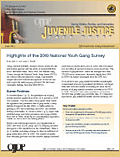
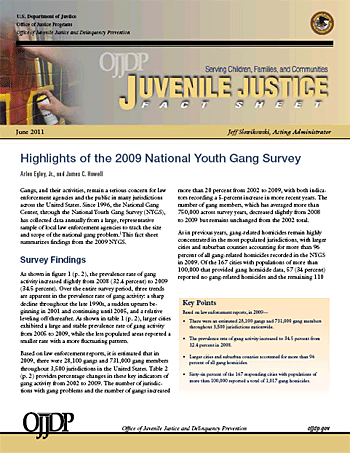 Highlights of the 2009 National Youth Gang Survey (Fact Sheet)
Highlights of the 2009 National Youth Gang Survey (Fact Sheet)
NCJ 233581
Gangs, and their activities, remain a serious concern for law enforcement agencies and the public in many jurisdictions across the United States. Since 1996, the National Gang Center, through the National Youth Gang Survey (NYGS), has collected data annually from a large, representative sample of local law enforcement agencies to track the size and scope of the national gang problem. This fact sheet summarizes findings from the 2009 NYGS. Included among the key findings were that the prevalence rate of gang activity increased to 34.5 percent in 2009 from 32.4 percent in 2008. Larger cities and suburban counties accounted for more than 96 percent of all gang homicides. The fact sheet also includes a trend analysis showing that gang violence rates have remained high over the past decade. For more information on the analysis, see the article entitled "Survey Indicates That Gang Activity Continues at High Levels" in this issue.
To order a printed copy, visit the NCJRS Web site.
Publications Released on Missing Children's Day (May 25, 2011)
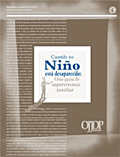
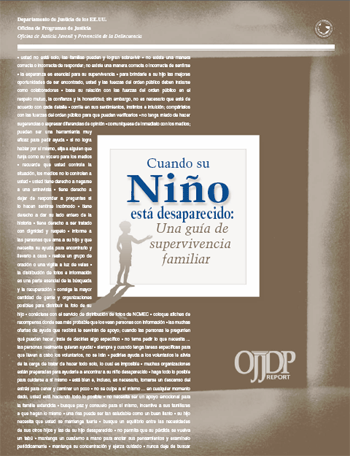 Cuando su niño está desaparecido: Una guía de supervivencia familiar (Guide)
Cuando su niño está desaparecido: Una guía de supervivencia familiar (Guide)
NCJ 232789
Cuando su niño está desaparecido: Una guía de supervivencia familiar is the Spanish-language translation of When Your Child Is Missing: A Family Survival Guide. Written by parents who have experienced the trauma of a missing child and who want to help other parents facing the same overpowering loss, the guide provides firsthand knowledge and sound advice about what to do when your child is missing, whom to contact, and how to best help law enforcement.
To order a printed copy, visit the NCJRS Web site.
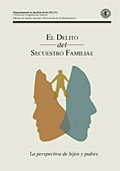
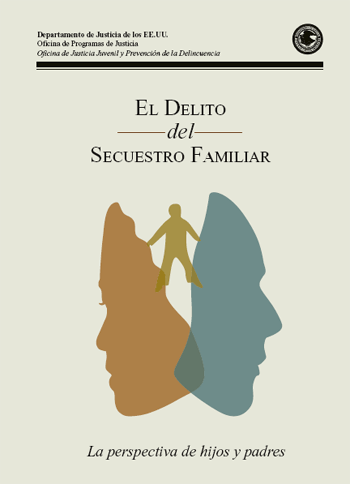 El delito del secuestro familiar: La perspectiva de hijos y padres (Guide)
El delito del secuestro familiar: La perspectiva de hijos y padres (Guide)
NCJ 234086
El delito del secuestro familiar: La perspectiva de hijos y padres is the Spanish-language translation of The Crime of Family Abduction: A Child's and Parent's Perspective. Authored by survivors of family abduction, this publication provides the searching family, law enforcement, and mental health professionals with strategies to build a comprehensive, child-centered approach to recovery and healing. This publication dispels the prevailing misconceptions surrounding family abduction by providing a firsthand account of the psychological trauma and physical dangers often faced by children who are abducted by family members. The booklet includes strategies to help parents searching for their children to cope with the aftermath of the abduction and provides suggestions for assisting the child during the transition from abduction to life after he or she has been recovered.
To order a printed copy, visit the NCJRS Web site.
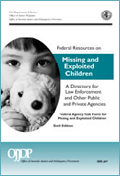
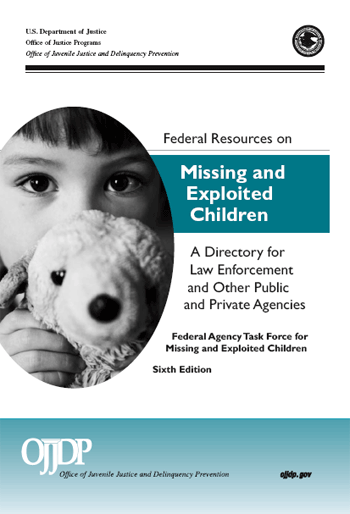 Federal Resources on Missing and Exploited Children: A Directory for Law Enforcement and Other Public and Private Agencies, Sixth Edition (Directory)
Federal Resources on Missing and Exploited Children: A Directory for Law Enforcement and Other Public and Private Agencies, Sixth Edition (Directory)
NCJ 231619
First published in 1996, Federal Resources on Missing and Exploited Children is designed to be used by agencies and organizations involved in the safe recovery of missing children. It contains the most up-to-date information about and links to the 16 federal and 2 nonfederal agencies that make up the Federal Agency Task Force for Missing and Exploited Children. The directory is a compilation of services, programs, publications, and training offered by these agencies to address the issues of child sexual exploitation, child pornography, child abduction, and missing children cases. The new edition of the directory has been redesigned to provide comprehensive, accessible agency information in a concise, user-friendly format.
To order a printed copy, visit the NCJRS Web site.
 News From the Coordinating Council on Juvenile Justice and Delinquency Prevention
News From the Coordinating Council on Juvenile Justice and Delinquency Prevention To read about the highlights of the May 23, 2011, meeting of Coordinating Council
on Juvenile Justice and Delinquency Prevention, see the article entitled "School
Disciplinary Strategies Discussed at Meeting of Coordinating Council on Juvenile Justice and
Delinquency Prevention" in this issue.
The next meeting of the council is scheduled for July 21, 2011. Meetings of the council are open to the public.
Visit the Web site to learn more about the council and read minutes from past meetings.
The Coordinating Council on Juvenile Justice and Delinquency Prevention is an independent body within the executive branch of the federal government operated under the Federal Advisory Committee Act. The council's primary functions are to coordinate federal juvenile delinquency prevention programs, federal programs and activities that detain or care for unaccompanied juveniles, and federal programs relating to missing and exploited children.
The council is made up of 22 members—13 ex officio and affiliate members and 9 practitioners. The ex officio members are: the Attorney General; the Administrator of the Office of Juvenile Justice and Delinquency Prevention; the Secretaries of the U.S. Departments of Education, Health and Human Services (HHS), Housing and Urban Development, and Labor; the Assistant Secretary of Immigration and Customs Enforcement in the U.S. Department of Homeland Security; the Director of the Office of National Drug Control Policy; and the Chief Executive Officer of the Corporation for National and Community Service. Affiliate members are the Secretaries of the U.S. Departments of Agriculture, Defense, and the Interior, and the Administrator of the Substance Abuse and Mental Health Services Administration of HHS. The nine juvenile justice practitioner members are appointed by the Speaker of the House of Representatives, the Senate Majority Leader, and the President of the United States.
 News From the Federal Advisory Committee on Juvenile Justice
News From the Federal Advisory Committee on Juvenile Justice
The committee's meetings are open to the public; anyone may register to
attend and observe. Additional information is available on the committee's
Web site.
The Federal Advisory Committee on Juvenile Justice is a consultative body established by the Juvenile Justice and Delinquency Prevention Act of 1974, as amended (Section 223) and supported by OJJDP. Composed of members of state advisory groups on juvenile justice, the committee advises the President and Congress on matters related to juvenile justice, evaluates the progress and accomplishments of juvenile justice activities and projects, and advises the OJJDP Administrator on the work of OJJDP.